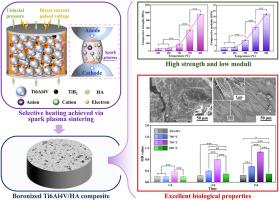低温放电等离子烧结制备硼化Ti6Al4V/HA复合材料
IF 7.7
2区 材料科学
Q1 MATERIALS SCIENCE, COMPOSITES
引用次数: 0
摘要
将Ti6Al4V、HA和TiB2混合粉末在600℃~ 800℃低温下烧结5 min,成功制备了硼化Ti6Al4V/HA复合材料,用于牙种植。结果表明,在650℃以下,复合材料烧结不充分,力学性能较差。当温度升高到700℃时,SPS的局部电热效应使粉末接触点温度升高,从而显著增强烧结性能。750℃时,TiB2原位转化为TiB,进一步改善了复合材料的致密化和力学性能。当烧结温度上升到800℃时,尽管复合材料的力学性能不断提高,但HA分解明显,生物活性降低。在750℃的最佳温度下,SPS得到的复合材料具有较高的抗压强度(544.2 MPa),较低的抗压模量(12.28 GPa)接近牙槽骨的抗压模量,以及较高的维氏显微硬度(297.0 HV)。此外,与Ti6Al4V相比,复合材料表现出优越的生物学性能,细胞增殖和骨整合能力分别提高了4.4倍和2.7倍,证实了其在种植体方面的适用性。本文章由计算机程序翻译,如有差异,请以英文原文为准。

Synthesis of boronized Ti6Al4V/HA composites by low-temperature spark plasma sintering
Boronized Ti6Al4V/HA composites were successfully synthesized for dental implantation by spark plasma sintering (SPS) of mixed Ti6Al4V, HA, and TiB2 powders in a low temperature range 600 °C–800 °C for only 5 min. It was demonstrated that below 650 °C the composites showed inadequate sintering and exhibited inferior mechanical properties. As the temperature increased to 700 °C, the localized electrothermal effect of SPS produced elevated temperatures at powder contact points, thereby markedly enhancing sintering. At 750 °C, TiB2 was in situ transformed into TiB, which further improved densification and mechanical properties of the composite. When the sintering temperature rose to 800 °C, despite the continuous improvement of mechanical properties of the composite, HA decomposed significantly which lowered the bioactivity. By SPS at the optimal temperature, 750 °C, the resulting composite exhibited high compressive strength (544.2 MPa), low compressive modulus (12.28 GPa) close to that of alveolar bone, and high Vickers microhardness (297.0 HV). Additionally, compared to Ti6Al4V, the composite demonstrated superior biological properties, with cell proliferation and osseointegration increased by 4.4-fold and 2.7-fold, respectively, confirming its suitability for dental implant applications.
求助全文
通过发布文献求助,成功后即可免费获取论文全文。
去求助
来源期刊

Composites Communications
Materials Science-Ceramics and Composites
CiteScore
12.10
自引率
10.00%
发文量
340
审稿时长
36 days
期刊介绍:
Composites Communications (Compos. Commun.) is a peer-reviewed journal publishing short communications and letters on the latest advances in composites science and technology. With a rapid review and publication process, its goal is to disseminate new knowledge promptly within the composites community. The journal welcomes manuscripts presenting creative concepts and new findings in design, state-of-the-art approaches in processing, synthesis, characterization, and mechanics modeling. In addition to traditional fiber-/particulate-reinforced engineering composites, it encourages submissions on composites with exceptional physical, mechanical, and fracture properties, as well as those with unique functions and significant application potential. This includes biomimetic and bio-inspired composites for biomedical applications, functional nano-composites for thermal management and energy applications, and composites designed for extreme service environments.
 求助内容:
求助内容: 应助结果提醒方式:
应助结果提醒方式:


